

this article originally appeared in a shorter version here
http://www.artaccess.com/articles/12634620
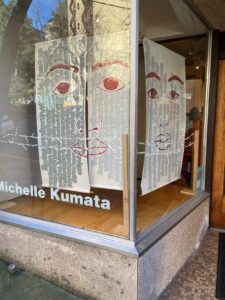
Bonfire Gallery “Michelle Kumata: Regeneration” to March 26
We are compelled to enter “Regeneration,” Michelle Kumata’s exhibition at the Bonfire Gallery by the banners in the gallery windows.
In the exhibition, Kumata is addressing the difficult subject of the long term legacies of the illegal incarceration of Japanese Americans during World War II.
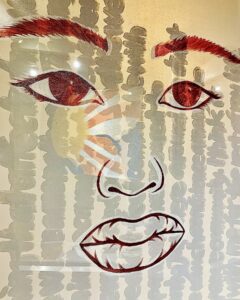 On the left of the entrance hangs “American Tragedy”, two banners depicting barely referenced facial features against a vague gray background behind real barbed wire. One has the face split between two banners, much as the experience of incarceration split the lives of those who were sent to those remote camps for up to four years.
On the left of the entrance hangs “American Tragedy”, two banners depicting barely referenced facial features against a vague gray background behind real barbed wire. One has the face split between two banners, much as the experience of incarceration split the lives of those who were sent to those remote camps for up to four years.
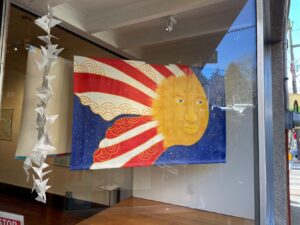
In the facing window, the banner “Shine” in brilliant color, suggests flying through the air, the Regeneration of the title of the exhibition.
Also in the window paper butterflies, made by a young Gosei (fifth generation) artist flutter toward the ceiling.
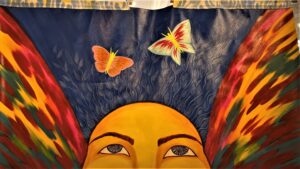
Inside the gallery “Butterfly Sun,” features a face that rises up
between butterfly wings.
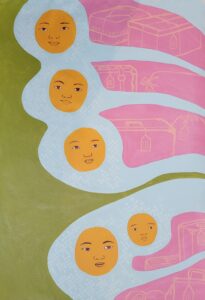
Nearby “what We Carry” also soars toward healing.
You can just see their luggage outlined in the wings.
As we watch the Ukrainians leaving their country with a single bag, it reminds us that they are being as brutally uprooted as the Japanese in 1942.

Michelle Kumata a three and a half generation Japanese American artist, explores the long term effects for her parents, the Sansei generation, who were born in incarceration during World War II as a result of Franklin Roosevelt’s Executive Order 9066. This generation is the last to have a direct connection to this abrupt violation of human rights.
It is a cautionary tale that refers directly to contemporary racism, forced exodus, and migration because of climate change.
“Regeneration” poignantly explores the ways in which incarceration survives into daily lives: the Japanese American community continues to be affected by the conditions that led to the incarceration.
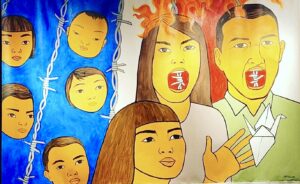
Michelle Kumata offers a multimedia approach to recovering memory and experiencing loss after decades of suppression. The largest expression of that, at the back of the gallery, is the lower section of the artist’s trademark work “Song for Generations.”
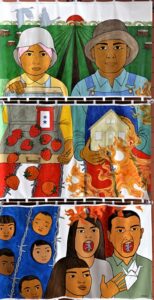
The entire banner represents a dignified husband and wife at the top, with their lush fields behind them, cleared from forest; in the next panel, strawberries fall to the ground and a house is burning. The bottom section, in the Bonfire exhibition, dramatically represents the ongoing pain of the incarceration with barbed wire in the open mouths of two Nikkei and flames around their heads. The strawberries become children, those born in the camps amidst barbed wire, but at the very bottom, a girl lets fly away a paper crane. You can see the whole mural in a small print nearby.
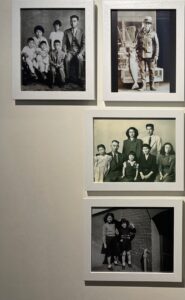
The next section of the exhibition features photographs of the artist’s maternal and paternal grandparents that document their lives before, during and after incarceration. The artist’s mother and father were born in the camps. These touching images speak to the real family stories of immigrants who had businesses and lives destroyed in 1942.
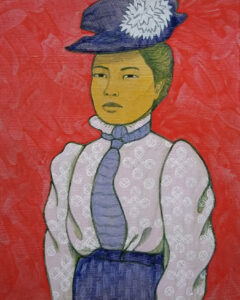
Gibson Garu
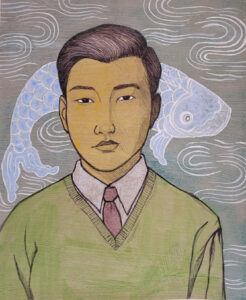
Koinobori
A similar feeling comes from paintings based on formally posed portrait photographs from the Takano Studio Collection from the late 1930s to early 1940s, called here “Nihonmachi portraits”
( Nihonmachi is the name of the Japanese business area of the International District before the incarceration.) The artist recreates a selection of these dignified portraits as paintings, again referring to lives before the camps.
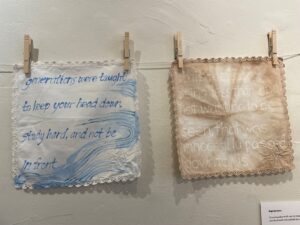
Facing these is a creative expression of memory: handkerchiefs with inscriptions such as “Generations were taught to keep your head down, study hard, and not be in front.”
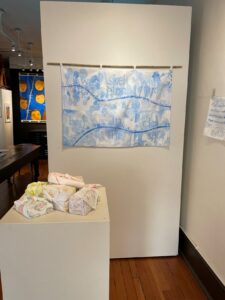
Nearby are “furoshiki” traditional Japanese wrappings for packages, here holding unspoken memories. Over generations as the artist states “the knots slowly loosen, releasing the pain, shame and anger. And we allow ourselves room to carve and define our own unique identities, to transform and fly.”
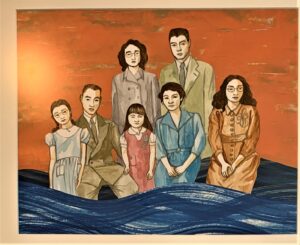
Resilience A Portrait of the Artists Maternal Grandparents
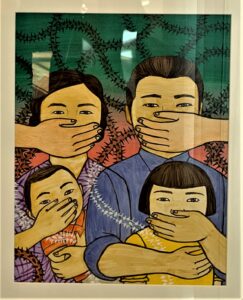
Be Quiet the alienation and oppression of Japanese Brazilians during World War II
In addition to all of these thoughtful approaches, a slide show of photographs alternates with quotes from a broad selection of members of our contemporary Japanese American community. The destruction of the heart of the Japanese community, Nihonmachi, and the unwillingness of survivors to speak of it are two major themes.

Bellevue Art Museum “Emerging Radiance, Honoring the Nikkei Farmers of Bellevue” to March 13
Michelle Kumata has a second major installation at the Bellevue Museum of Art “Emerging Radiance, Honoring the Nikkei Farmers of Bellevue.”
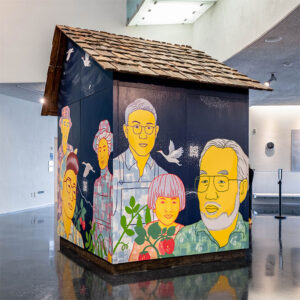
It features an immersive mural that uses augmented reality that enables us to actually hear three Nissei farmers of Bellevue tell their stories. The stories are based on interviews recorded in the Densho Digital Archive an incredible online resource that expands our understanding of the lives of those who were incarcerated.
YOu can hear the testimonies on her website
Michelle Kumata boldly experiments with representing the ongoing psychological damage of the original historical event of Japanese incarceration. She creatively makes audible what has been unspoken and makes visible what has been buried.